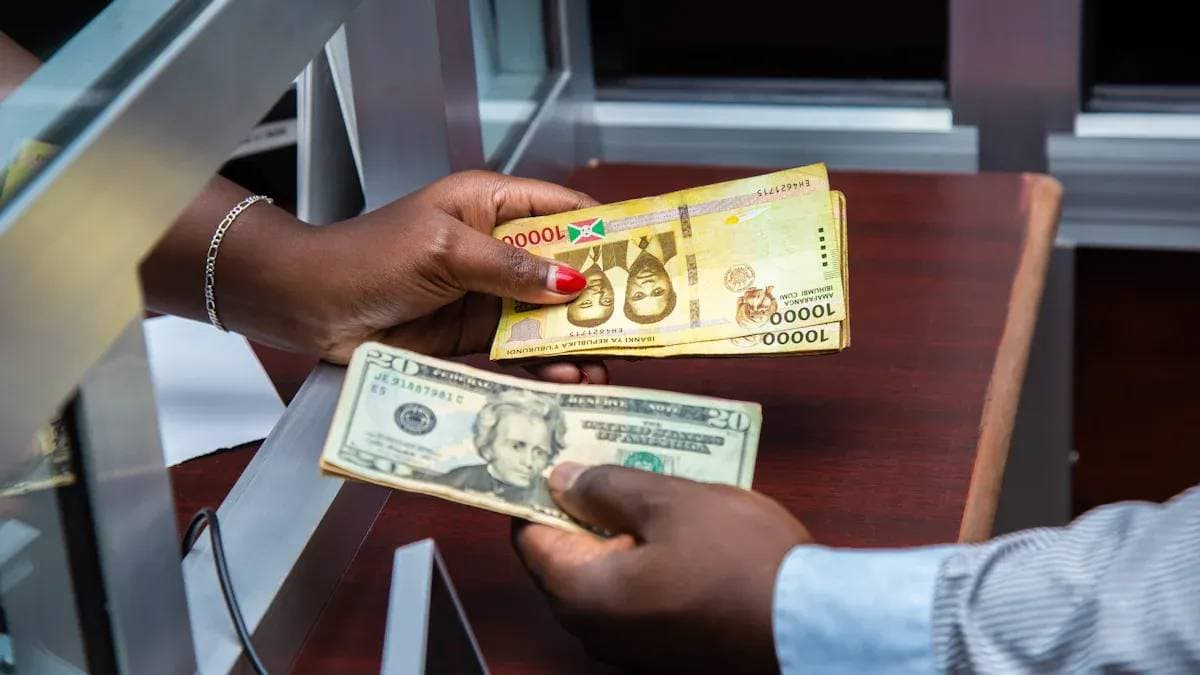- EasyCard
- Trade
- Help
- Announcement
- Academy
- SWIFT Code
- Iban Number
- Referral
- Customer Service
- Blog
- Creator
2025 USDT Remittance Guide: Fee Calculation and Best Practices

Image Source: pexels
When people calculate stablecoin USDT remittance costs, they often only see Gas fees. A complete cost model actually includes three parts: entry cost, on-chain transfer cost, and exit cost. In contrast, traditional bank remittances remain expensive.
According to World Bank data, the global average remittance cost from 2024 to 2025 is 6.49%. Stablecoin transactions reduce costs to below 1.5%, with settlement time shortening from several business days to minutes.
This complete methodology will guide users to calculate real costs step-by-step and find the lowest-cost remittance path.
Core Highlights
- The total cost of USDT remittances includes three parts: entry, on-chain transfer, and exit, which is cheaper than traditional bank remittances.
- Users can buy USDT via C2C platforms or centralized exchanges and need to compare premiums and handling fees to choose the most cost-effective way.
- Choosing low-fee blockchain networks like TRC-20, BEP-20, or Polygon can significantly reduce USDT transfer costs.
- When converting USDT back to fiat currency, users should compare multiple platforms and choose low-spread trading pairs to minimize exchange rate losses.
- USDT remittances are faster and cheaper than traditional bank wires, especially suitable for small, high-frequency cross-border payments.
USDT Entry Cost: How to Calculate and Optimize?

Image Source: unsplash
Acquiring USDT is the first step in the remittance process, and its cost directly affects total expenditure. Users mainly obtain USDT through two channels: C2C platforms and centralized exchanges. Understanding and calculating the costs of these two methods is key to optimizing the remittance path.
Premium Costs on C2C Platforms
C2C (Customer-to-Customer) platforms allow users to buy USDT directly from other users. This method is convenient but usually involves a “premium.” This means the purchase price of USDT is higher than the real-time USD exchange rate. This premium is the merchant’s profit and risk cost.
Users can use a simple formula to calculate the real cost of C2C:
Premium Cost Rate = (Total Payment Amount - Equivalent USD of Received USDT) / Equivalent USD of Received USDT
For example, on mainstream platforms like Binance or OKX, C2C market premium rates usually fluctuate between 1% and 3%, depending on market supply-demand and payment methods.
Exchange Deposit and Trading Fees
For users with USD bank accounts, such as those holding Hong Kong bank accounts, depositing directly on exchanges is another option. This path has a clearer cost chain, mainly including three links:
- Bank Wire Fee: The transfer fee charged by the bank.
- Exchange Deposit Fee: Some exchanges charge for wire deposits.
- Trading Fee: The fee generated when exchanging USD to USDT (Taker/Maker Fee).
Taking Kraken and Coinbase as examples, their fee structures differ. Kraken is free for most cash deposit types, while Coinbase charges $10 for wire deposits. Trading fees also vary between the two platforms.
| Fee Type | Kraken | Coinbase |
|---|---|---|
| Wire Deposit | Free | $10 |
| Taker Fee | 0.40% - 0.08% | 0.60% - 0.05% |
| Maker Fee | 0.25% - 0% | 0.40% - 0% |
Entry Cost Comparison and Selection
The two entry methods have pros and cons; users need to choose based on their situation.
- C2C Platforms: Simple operation, fast arrival, suitable for small purchases. The disadvantage is uncertain premiums, with potentially higher total costs.
- Exchange Deposits: Transparent rates, clear cost advantages for large transactions. Disadvantages include slightly complex processes, need for bank account support, and waiting time.
Best Practice: Before buying USDT, users should estimate C2C premium costs and total exchange deposit fees based on the planned purchase amount, then choose the lower-cost path.
Stablecoin USDT vs Traditional Remittances: Cost and Efficiency Comparison

Image Source: unsplash
After understanding USDT’s cost structure, it is necessary to compare it with traditional remittance methods. Traditional bank wires and remittance services, though long-established, show clear disadvantages in fees and efficiency.
Fee Structure Comparison Analysis
Traditional bank international wires via the SWIFT network have complex and opaque fee structures. The cost of a remittance is usually stacked from multiple parts, making it hard for users to estimate the final received amount.
Traditional Wire Fee Components
Fee Type Cost Range Sending Bank Fee $25 - $50 Intermediary Bank Fee $10 - $30 (per bank) Receiving Bank Fee $15 - $25 Currency Conversion Cost 2% - 5% (exchange rate markup)
Besides banks, services like Western Union also have hidden costs. Their main profit comes from “exchange rate markups,” providing rates below the mid-market rate to earn spreads. For example, when remitting 1,000 USD, unfavorable rates may cause extra losses of up to $40 to $50. In contrast, the stablecoin USDT cost model (entry + on-chain + exit) is clearer, allowing users to actively choose low-cost networks to control expenses.
Transaction Speed and Convenience
Speed is another major advantage of USDT remittances. Traditional wires rely on bank business days and clearing times, usually taking 3 to 5 business days. If involving multiple intermediaries or holidays, time is longer.
USDT transfers run on blockchain, unrestricted by bank hours, enabling 24/7 transactions. A transfer usually confirms in minutes, allowing immediate use or cash-out by the recipient. This near-instant settlement greatly facilitates time-sensitive fund flows.
Global Application Scenario Overview
With low costs and high efficiency, USDT is becoming a new choice for global cross-border payments, especially in emerging markets with imperfect traditional finance.
- B2B Trade Settlements: African importers use USDT to pay mainland Chinese suppliers, bypassing cumbersome bank processes and accelerating procurement cycles.
- Freelancer Payments: Remote workers in Nigeria and Argentina prefer receiving USDT as compensation. This helps avoid local currency devaluation risks and high bank fees.
- SME Payments: Some SMEs use USDT for cross-border transactions to reduce FX risks and ensure smoother fund flows.
These real cases show stablecoin USDT provides a reliable and economical alternative for global users.
On-Chain Transfer Cost: Network Selection and Gas Fee Optimization
Choosing the right blockchain network is the core link to controlling USDT remittance costs. USDT exists on different blockchains with different token standards, with huge differences in transfer fees (Gas fees) and speeds. Users’ active choices directly determine this link’s expenditure.
Mainstream Blockchain Gas Fee Comparison
When users send USDT, they are actually conducting a transaction on a specific blockchain, needing to pay network miners or validators. Different networks’ processing capacities and congestion vary, leading to vastly different fees.
Mainstream Network Fee and Speed Comparison
Network Token Standard Average Fee (USD) Average Confirmation Time Tron TRC-20 $1.0 - $2.0 Seconds Ethereum ERC-20 $1.0 - $3.0+ 1-5 minutes BSC BEP-20 $0.03 - $0.1 Seconds Polygon Polygon ~$0.01 Seconds Solana SPL ~$0.001 Seconds
From the table, Tron (TRC-20) and BSC (BEP-20) excel in cost and speed. Especially TRC-20, with low fees and fast confirmations, has become the top choice for small, high-frequency remittances. Industry data shows TRON network stablecoin daily volume consistently exceeds $24 billion, proving its market dominance.
Gas Fee Query and Estimation Methods
Gas fees fluctuate in real time, affected by network congestion. During peaks, fees on networks like Ethereum may soar. Therefore, querying real-time Gas fees before transfer is necessary to avoid unexpected high costs.
Users can use professional Gas tracking tools for real-time data:
- Etherscan Gas Tracker: (etherscan.io/gastracker) Designed for Ethereum, provides low, medium, high priority real-time Gas prices to help users evaluate costs and wait times.
- TRONSCAN: (tronscan.org) As TRON’s official explorer, users can view network status and energy consumption on its site to estimate transfer costs.
Operation Tip: Before sending stablecoin USDT, users should use these tools to check current fees. If fees are too high, wait for congestion to ease or switch to lower-cost networks.
Best Network Selection Practices
Which network to choose depends on users’ specific needs, mainly considering three factors: amount, timeliness, and recipient compatibility.
- Small, high-frequency remittances: For daily small payments or frequent transfers, prioritize TRC-20, BEP-20, or Polygon networks. Their costs are negligible and speeds fast.
- Large, low-frequency remittances: If security is paramount and the recipient only supports Ethereum, ERC-20 is reliable. Users should transfer during low-fee periods.
- Flexibility and ease: Some payment platforms like Biyapay integrate multiple mainstream networks. Users can directly choose low-cost networks like TRC-20 within the app, without managing multiple wallets, simplifying operations and optimizing costs.
Ultimately, the best practice is to prioritize the lowest-cost, fastest network while ensuring fund security and recipient support.
USDT Exit Cost: How to Calculate and Minimize Losses?
Converting USDT back to fiat currency is the final step in the remittance process. This link’s cost, “exit cost,” directly determines the recipient’s final received amount. Costs mainly come from trading platform exchange rate losses or withdrawal fees.
Exchange Rate Losses on C2C Platforms
C2C platforms are the most common channel for users to sell USDT for local fiat. Costs here mainly manifest as “exchange rate losses” or “spreads.” This means the selling price of USDT is usually slightly below real-time market rates, with the spread being the merchant’s profit. Spreads vary across platforms and trading pairs.
Some platforms offer more transparent fee structures. For example, payment apps like Biyapay integrate C2C trading, allowing easy in-app price comparison and trading. Others use fixed rates.
- BananaCrystal platform charges 1.99% fixed service fee.
- The platform claims no hidden exchange rate markups.
- Its fees are far below traditional remittance services.
Spread size also relates to trading pairs, with mainstream pairs usually having lower spreads.
| Trading Pair | Average Spread |
|---|---|
| USDT/USD | 0.01%-0.02% |
| USDT/AUD | 0.07% |
Offline OTC and ATM Costs
For users needing physical cash, offline OTC (over-the-counter) and cryptocurrency ATMs are options. However, these channels usually have very high costs. Cryptocurrency ATM fee structures are especially complex, involving multiple charges.
Cryptocurrency ATM Fee Example
- Conversion Fee: Usually 0.9% or higher.
- Withdrawal Fee: After monthly limits, may charge 2%.
- Hidden Costs: Some ATM operators charge extra access fees and use unfavorable rates for conversion, with total fees up to 7%-12% of withdrawal amount.
Therefore, ATMs are usually not the most economical way to convert crypto to cash, better for emergency small withdrawals.
Exit Cost Control Strategies
Minimizing exit costs lies in active comparison and selection. When selling stablecoin USDT, users can adopt these strategies:
- Multi-platform price comparison: Before selling, check quotes on multiple C2C platforms like Binance, OKX, and Biyapay. Choose the highest bidder with the best reputation.
- Choose low-spread trading pairs: If possible, prioritize converting USDT to mainstream fiat like USD, as these pairs usually have the lowest spreads.
- Plan withdrawal methods: Unless necessary, avoid large withdrawals via cryptocurrency ATMs. Prioritize online C2C platforms for better rates and lower fees.
Comprehensive Case and Cost Calculator
Theoretical knowledge helps users understand cost components, but a specific calculation case intuitively shows USDT remittance’s economic advantages. This section uses a real case to step-by-step calculate the total cost of remitting $1,000 and provides an interactive cost calculation framework to help users make optimal decisions for every remittance.
Case Calculation: Remitting $1,000
Assume a user needs to send $1,000 from Hong Kong to a recipient in the US. We compare costs and efficiency of two methods: traditional bank wire and USDT remittance.
Option One: Traditional Bank Wire
International wires via banks have complex, high fee structures. They usually involve sending, intermediary, and receiving bank fees, with opaque rates.
Traditional wire fees are usually high due to professional bank networks and currency conversion. Total fees for an international wire may range $30 to $80, or higher.
We estimate this $1,000 remittance cost:
| Fee Item | Estimated Cost (USD) | Explanation |
|---|---|---|
| Sending Bank Fee | $25 | Paid to the originating bank when initiating. |
| Intermediary Bank Fee | $20 | Funds may pass one or more banks in international networks. |
| Receiving Bank Fee | $15 | Charged by the receiving bank for crediting funds. |
| Hidden FX Cost | $20 | Bank rates usually worse than mid-market, estimated at 2%. |
| Total Cost | ~$80 | - |
| Expected Arrival Time | 3-5 business days | - |
Option Two: USDT Remittance (Optimized Path)
The user chooses an optimized USDT remittance path: “low-premium C2C entry + low-cost network + low-loss C2C exit.”
- Entry Cost (Buying USDT) The user finds a reputable, low-premium merchant on a C2C platform, buying 1,000 USDT at 1.2% premium.
Cost = $1,000 * 1.2% = $12 - On-Chain Transfer Cost (Sending USDT) The user chooses the extremely low-cost TRC-20 network.
Cost = ~$1.5(TRON network average single transfer fee) - Exit Cost (Selling USDT) The US recipient sells USDT on a C2C platform for USD, assuming 0.8% loss.
Cost = $1,000 * 0.8% = $8
Cost Comparison Summary
| Comparison Dimension | Traditional Bank Wire | USDT Remittance (Optimized) |
|---|---|---|
| Total Cost | ~$80 | ~$21.5 |
| Expected Arrival Time | 3-5 business days | 5-10 minutes |
| Cost Savings | - | About 73% |
Through this case, users clearly see that choosing the right USDT remittance path costs far less than traditional wires. Remittance services, though cheaper than wires, usually cost $25-$45 and are much slower than USDT.
Interactive Cost Calculation Framework
Markets are dynamic; costs change per remittance. Therefore, users need a flexible calculation framework for real-time estimates. An ideal cost calculator should be based on this core formula:
Total Cost = Entry Cost + On-Chain Transfer Cost + Exit Cost
For accurate calculation, users need to consider these key input variables. These variables divide into user-controllable options and market dynamic factors.
- User-Controllable Variables
- Transaction Amount: The total remittance amount. Basis for percentage fee calculations.
- Blockchain Network: Choose TRC-20, BEP-20, or ERC-20? Fees differ hugely.
- Trading Platform: On which platform to buy/sell? Different platforms have varying rates and premiums.
- Transaction Speed: Some networks allow higher fees for faster confirmations.
- Transfer Time: Transferring during off-peak network hours can effectively reduce Gas fees.
- Market Dynamic Variables
- Network Congestion: Real-time blockchain traffic directly determines Gas fee levels.
- Exchange Rate Fluctuations: USDT-fiat rates affect final entry and exit fiat costs.
- Platform Policies: Platforms may adjust rates or launch promotions.
Fee Calculation Methods
The calculator also needs to distinguish two main fee types. One is fixed fees, unchanged regardless of amount (e.g., some withdrawal fees). The other is percentage-based fees, a percentage of the amount, so larger transfers incur higher fees (e.g., C2C premiums).
A professional interactive calculator accesses real-time info from external sources via APIs for accuracy.
- Real-Time Gas Fees: Integrate 1inch Business or Blocknative Gas fee APIs. They support Ethereum, BNB Chain, Polygon, etc., providing precise real-time Gas price estimates.
- Real-Time Exchange Rates: Integrate CoinAPI.io or Finage crypto APIs. They provide real-time rates for thousands of crypto-fiat pairs for precise entry/exit fiat cost calculations.
By understanding this framework, even without an automated calculator, users can manually query data for a fairly accurate total remittance cost estimate.
To minimize stablecoin USDT remittance costs, users need three core strategies. First, optimize entry using price comparison tools to find best quotes. Second, choose networks prioritizing TRC-20 or BEP-20 with fees usually below $1. Third, plan exit by timing and selecting merchants to reduce exchange losses.
Users should calculate complete real costs, not focus on single links. A global view tailors the most economical plan for every remittance.
FAQ
Is USDT Remittance Safe?
USDT remittances are highly secure when users follow practices. Transaction records are public and transparent on blockchain. Users must carefully verify recipient addresses, as transfers are irreversible once sent. Choosing reputable trading platforms also increases security.
Is USDT’s Value Really Stable?
USDT is a stablecoin pegged 1:1 to USD. Issuer Tether claims equivalent reserve assets back it. Despite minor market fluctuations, it maintains stable USD exchange rates most of the time. Users can treat it as digitized USD.
What If the Recipient Doesn’t Understand Crypto?
Some payment apps provide solutions. The sender pays with USDT, while the recipient receives local fiat directly. These platforms handle conversion in the background. This allows non-crypto users to easily receive funds, lowering the barrier.
Which Blockchain Network is the Best Choice?
No absolute “best” network exists; users choose based on needs.
- Small, high-frequency: TRC-20 and BEP-20 are top choices for low fees and high speeds.
- High security: ERC-20 offers high security but higher fees. Users balance cost, speed, and security.
*This article is provided for general information purposes and does not constitute legal, tax or other professional advice from BiyaPay or its subsidiaries and its affiliates, and it is not intended as a substitute for obtaining advice from a financial advisor or any other professional.
We make no representations, warranties or warranties, express or implied, as to the accuracy, completeness or timeliness of the contents of this publication.




Contact Us
Company and Team
BiyaPay Products
Customer Services
BIYA GLOBAL LLC is a licensed entity registered with the U.S. Securities and Exchange Commission (SEC No.: 802-127417); a certified member of the Financial Industry Regulatory Authority (FINRA) (Central Registration Depository CRD No.: 325027); regulated by the Financial Industry Regulatory Authority (FINRA) and the U.S. Securities and Exchange Commission (SEC).
BIYA GLOBAL LLC is registered with the Financial Crimes Enforcement Network (FinCEN), an agency under the U.S. Department of the Treasury, as a Money Services Business (MSB), with registration number 31000218637349, and regulated by the Financial Crimes Enforcement Network (FinCEN).
BIYA GLOBAL LIMITED is a registered Financial Service Provider (FSP) in New Zealand, with registration number FSP1007221, and is also a registered member of the Financial Services Complaints Limited (FSCL), an independent dispute resolution scheme in New Zealand.




















